Slender rasbora facts for kids
Quick facts for kids Slender rasbora |
|
|---|---|
 |
|
| Conservation status | |
| Scientific classification | |
| Synonyms | |
|
The black-line rasbora or slender rasbora (Rasbora daniconius) is a small, active fish. It is also known as darka in some places like Rangpur. This fish belongs to the cyprinid family, which includes many types of ray-finned fish like minnows and carp.
These interesting fish are found in rivers across a wide area. They live in South and Southeast Asia. You can find them from Sri Lanka and the Indus river basin all the way to the northern part of the Malay Peninsula and the Mekong river.
Contents
What Does the Black-Line Rasbora Look Like?
The black-line rasbora has a body shape that is long and somewhat flat from side to side. It looks like it has been gently squeezed. This fish can grow up to about 15 centimeters (or 6 inches) long.
Its head is about as wide as the part of its head behind its eyes is long. This gives it a streamlined shape, which helps it move quickly through the water.
Where Do They Live?
Black-line rasboras are freshwater fish. This means they live in rivers, streams, and sometimes lakes, not in the ocean. They prefer clear, flowing water. Their wide range shows they can adapt to different river environments.
They are often found in schools, which means they swim together in groups. This helps them find food and stay safe from bigger fish.
What Do They Eat?
Like many small fish, black-line rasboras are likely omnivores. This means they eat both plants and small animals. Their diet probably includes tiny insects, small crustaceans, and plant matter found in the water. They are important for the food web in their habitats.
Conservation Status
The black-line rasbora is currently listed as "Least Concern" by the IUCN (International Union for Conservation of Nature). This means that, for now, their populations are stable and they are not considered to be at high risk of disappearing. However, it's always important to protect their habitats to keep them healthy.


